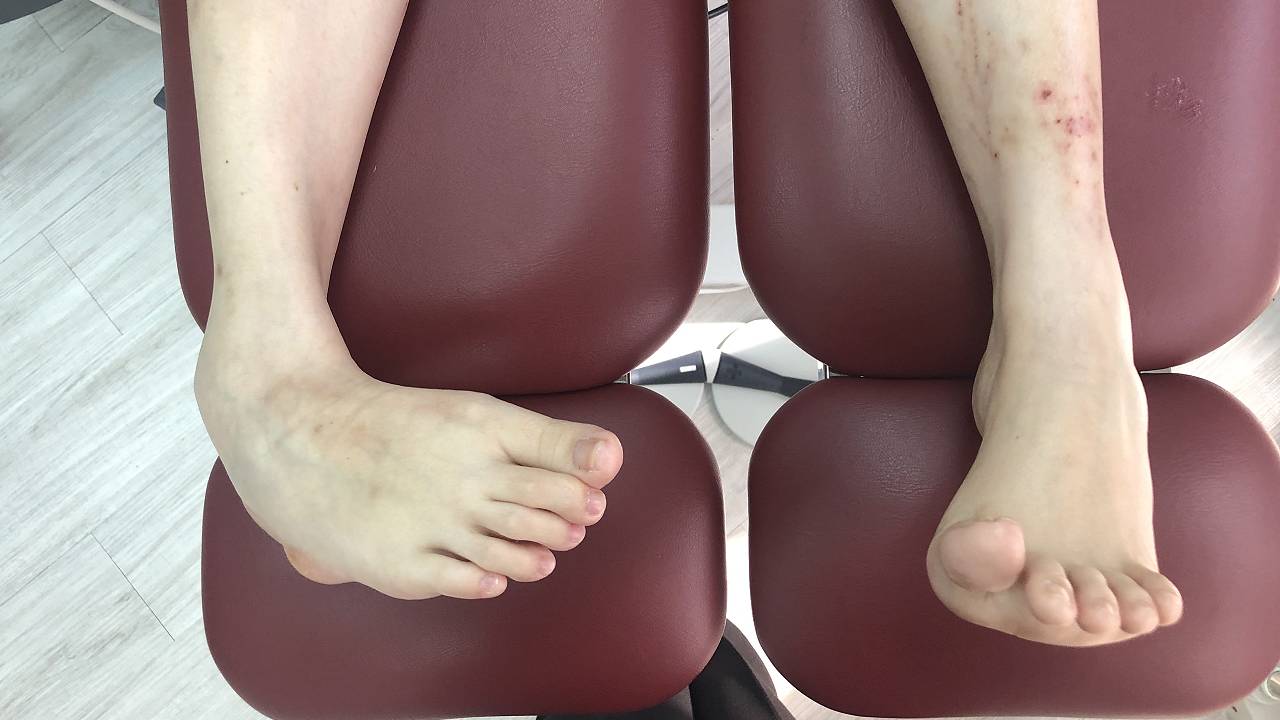There are many causes of ankle injuries, including but not limited to biomechanical abnormalities, diseases that cause ankle instability, and trauma. In Singapore, ankle sprains account for up to 85% of ankle injuries.
There are various chronic conditions that cause ankle pain. It can be the result of unresolved fracture, Peroneal Tendon injuries, Posterior Tibial Tendon Dysfunction (PTTD), gout, rheumatoid arthritis, Tarsal tunnel syndrome (nerve compression), infection and poor structural alignment such as flat foot.
Patients suffering from ankle pain frequently report symptoms of swelling, stiffness and redness in the affected area. Pain can range from a dull ache to a sharp burning pain that occurs during weight bearing activities, such as standing or walking.

Since the cause of ankle pain is often ambiguous, it is crucial for people suffering from ankle pain to seek consultation from a healthcare professional. An ankle specialist, such as a podiatrist, will be able to perform a thorough foot assessment using diagnostic tools, such as a musculoskeletal diagnostic ultrasound to determine the source of your ankle pain. Most ankle conditions can be improved using non-invasive solutions offered by our podiatrists. If surgery is required, your podiatrist will refer you to a trusted foot and ankle doctor for surgical solutions.
For temporary pain relief and comfort, you may try the following steps at home:
- REST the foot
- ICE the ankle for pain relief
- ELEVATE the foot to help with the swelling
- IMMOBILISE the ankle to avoid further worsening of the condition
However, if pain persists or worsens despite home remedies, you should visit a podiatrist for proper assessment and management. This may consist of immobilising the area with splints or utilising technological therapies, such as EMTT, to facilitate recovery.
Some potential conditions associated with ankle pain are as follows:

It is advised by ankle specialists and podiatrists to address your ankle pain and sprains promptly. Failure to do so can lead to irreversible deformities of the foot and ankle, and even cause disabilities that negatively affect your quality of life.
To prevent this, see a podiatrist if you have experienced multiple ankle sprains, or frequent ankle instability and weakness.
Frequently Asked Questions
An ankle sprain is an injury of the ligaments around the ankle due to excessive rolling or twisting. When this occurs, the ligaments are stretched beyond their normal range of motion, and in severe cases, may result in the tearing of the ligament. Ankle sprains are the most common ankle injury in Singapore.
While ankle sprains are usually caused by a single event, such as a fall, landing awkwardly after a jump, or having someone step or land on your foot, there are often underlying causes that contribute to ankle sprains. This may include, previous ankle injury, poor footwear choices or a lack of flexibility or strength in the ankle. Previous ankle injuries are a major culprit as they weaken your ankle, hence increasing the incidence of such injuries. To avoid this from occurring, consult an ankle specialist or podiatrist to see what are the options are available for you.
You usually know when you have sprained your ankle because of the very noticeable twisting or turning motion. Other common symptoms can include:
- Pain, particularly upon weight-bearing
- Soreness and/or tenderness
- Swelling
- Bruising
- Restricted range of motion
- Popping sensation or sound at the time of injury
If the pain persists over a prolonged period of time, or greatly intensifies upon weight bearing, the ankle may have been fractured rather than sprained. You should always consult a podiatrist or lower limb specialist to ensure that there is no lasting damage.
While ankle injuries can heal on their own, they often heal incorrectly or in a manner that encourages future injury.
A severe ankle sprain may take several months to fully recover. If neglected, complications such as chronic ankle instability or even ankle arthritis may occur. Therefore, it is important to address the underlying cause of these injuries in order to implement appropriate preventive measures.
Depending on the severity and type of injury, the course of action for ankle sprains can range from applying R.I.C.E to the affected area, to using crutches or splints, to using electromagnetic stimulation to help facilitate recovery.
For both mild and severe injuries, physical therapy may be prescribed for rehabilitation purposes. Surgical intervention is rare, and is typically only offered if there is significant bone deterioration or if conservative methods have failed to stabilise the ankle joint after an extended period of therapy.
Surgery is rarely required for ankle sprains as the ligaments of the ankle can remodel themselves. Nonetheless, you should seek help from a foot specialist or podiatrist to avoid injury progression and future injury.




